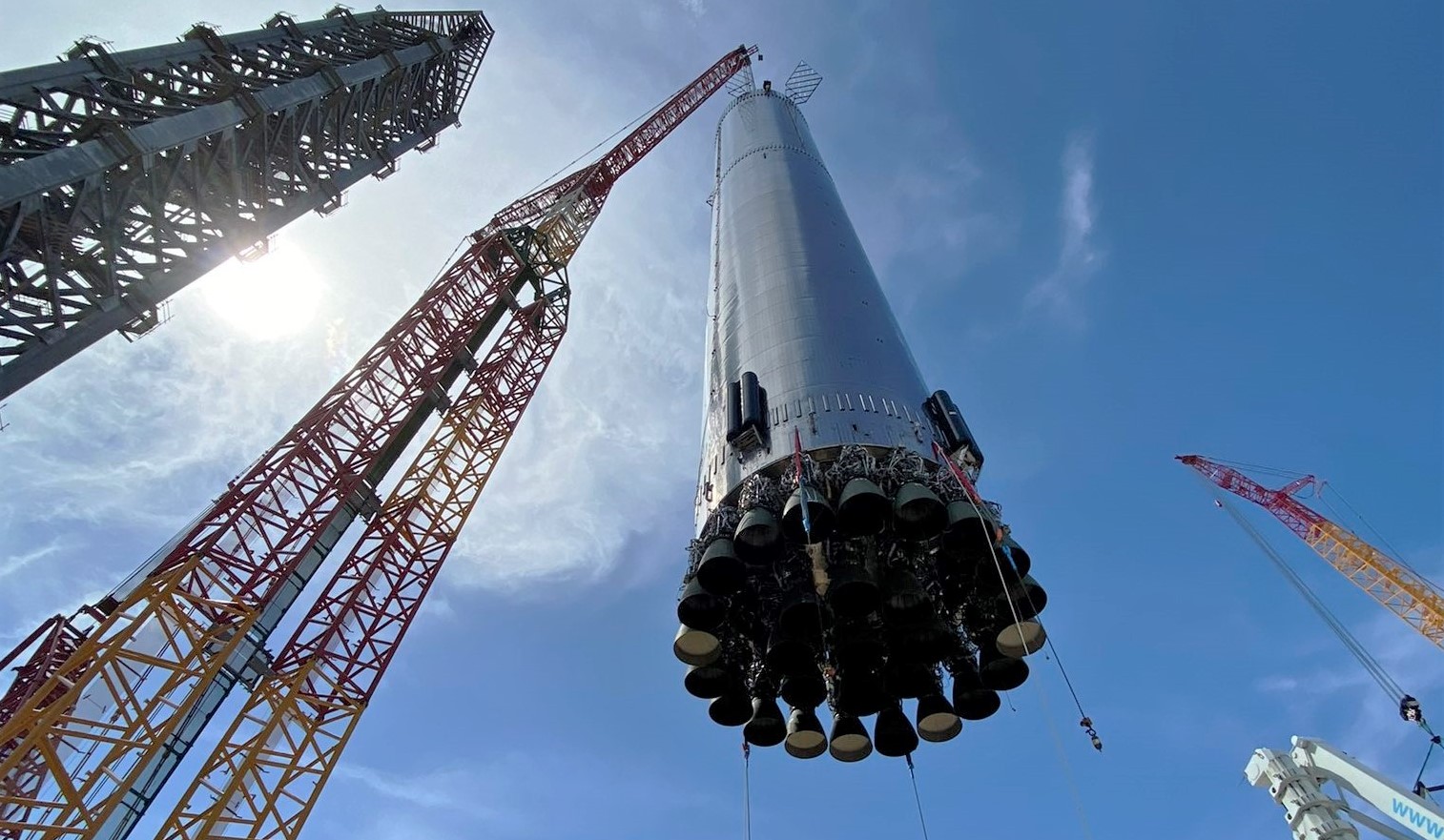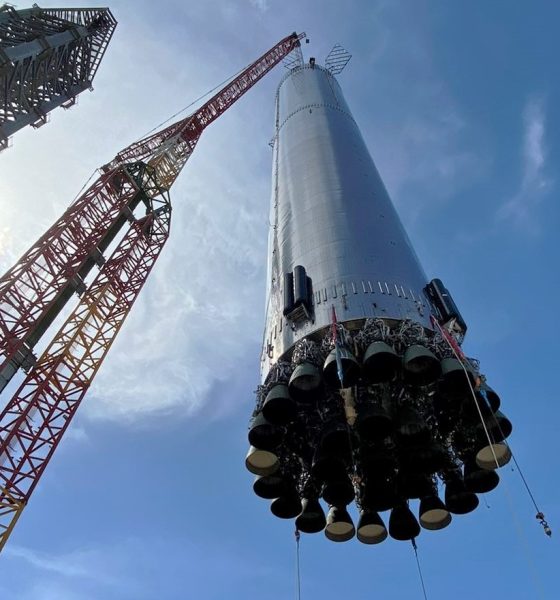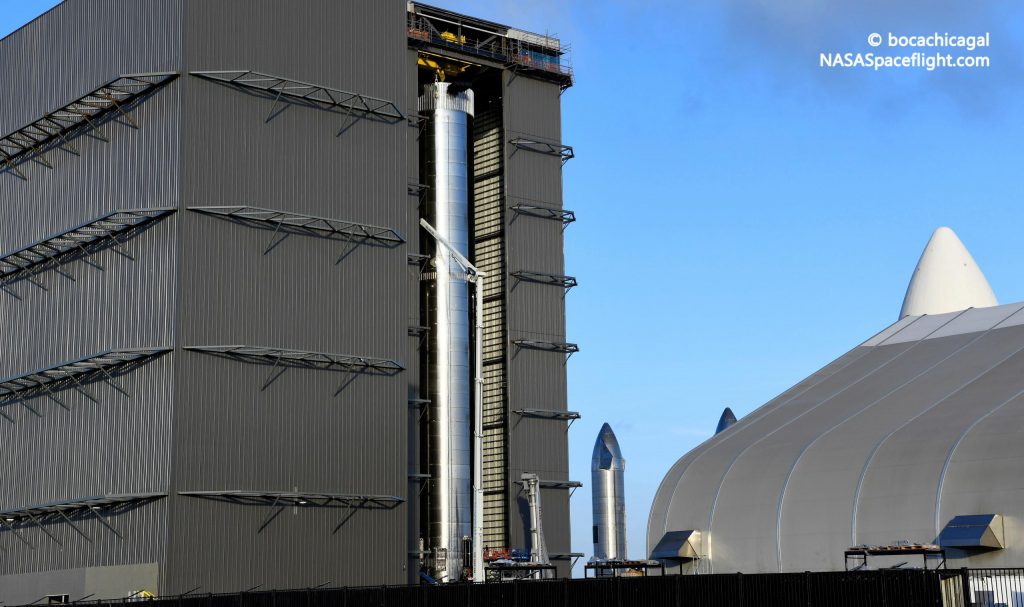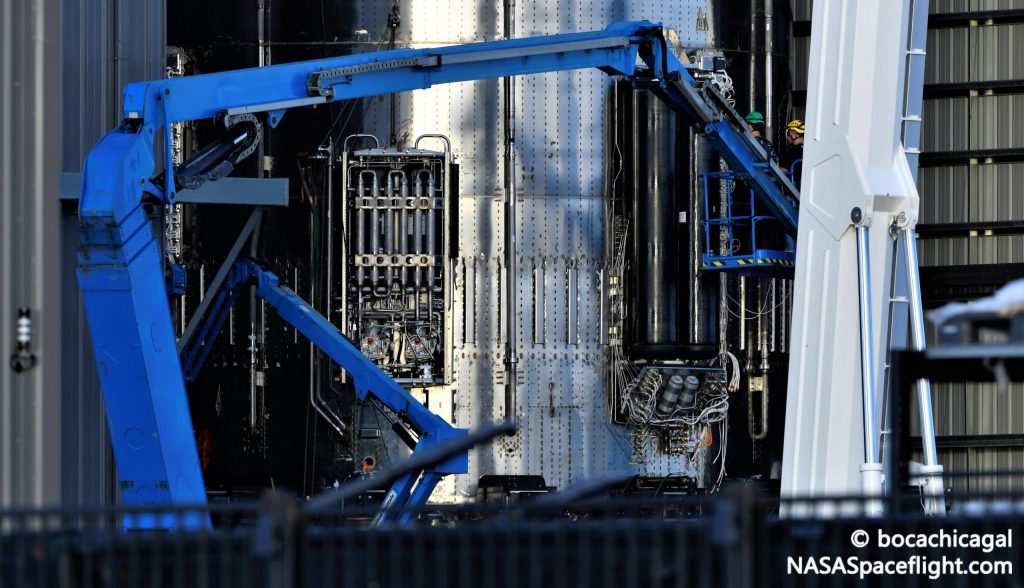

News
SpaceX reinstalling 29 Raptor engines on first orbital-class Starship booster
For the second time this month, SpaceX has begun installing 29 Raptor engines on Starship’s first orbital-class Super Heavy booster, potentially paving the way for several crucial milestones.
On August 1st, around the same time as SpaceX finished installing car-sized grid fins on a Super Heavy for the first time, the company began the process of installing multiple Raptor engines on the booster (#4) that might one day support Starship’s first orbital launch attempt. Not long after it began, it became clear that SpaceX was installing a full 29 Raptor engines on Booster 4 (B4) at a breakneck pace, and less than 24 hours later, all had been attached to Super Heavy’s thrust structure.
Barely a day later, Super Heavy Booster 4 was rolled to the orbital launch pad and installed on a massive ‘launch table’ that was itself installed just a few days prior after months of assembly. Four days after engine installation, Starship S20 and Booster 4 were briefly mated together, forming a full Starship stack – the tallest and most powerful rocket ever built – for about an hour. However, while it did serve as a useful learning experience and pathfinder operation, both stages were demated and returned to the factory soon after.
Since Booster 4’s later August 11th build site return, SpaceX teams have been hard at work fitting the massive 69m (225 ft) tall rocket booster with thousands of feet (if not miles) of secondary plumbing and power and avionics cables. That process effectively began with removing the Super Heavy’s 29 Raptor engines, which finished just a few days after its return to the high bay.


Now, just 12 days after Super Heavy Booster 4 arrived back at the high bay and 11 days after workers briskly removed its Raptors, SpaceX has begun the process of reinstalling those engines – albeit with several new entrants this time around. When SpaceX first fitted B4 with Raptors, it became clear that five or more of had never been tested, making the removal of some of the Super Heavy’s 29 engines more or less inevitable. Indeed, as expected, several new Raptors (engines that weren’t clearly installed the first time around) have joined around two dozen engines that were installed earlier this month.
Given that Booster 4 has already completed a range of fit checks, the implication is that SpaceX is now installing the 29 Raptor engines that will support the first static fire test campaign of a flightworthy Super Heavy. Of course, that testing (likely involving several different static fires of an increasing number of Raptors) could unearth issues or even damage some of those 29 Raptors, so it isn’t quite accurate to say that Booster 4 is being fitted with the engines that will help it carry Starship to orbit. Depending on the outcome of those tests, though, most could easily find themselves lifting off on Super Heavy B4 later this year.
For now, though, Super Heavy Booster 4’s next milestone will be its second trip from the build site to the launch pad. That could occur at any point in the next week or two and could find Booster 4 installed beside Ship 20 on the second of two suborbital test stands, though the Super Heavy may instead return to the orbital launch site.

News
Tesla China delivery centers look packed as 2025 comes to a close
Needless to say, it appears that Tesla China seems intent on ending 2025 on a strong note.

Tesla’s delivery centers in China seem to be absolutely packed as the final days of 2025 wind down, with photos on social media showing delivery locations being filled wall-to-wall with vehicles waiting for their new owners.
Needless to say, it appears that Tesla China seems intent on ending 2025 on a strong note.
Full delivery center hints at year-end demand surge
A recent image from a Chinese delivery center posted by industry watcher @Tslachan on X revealed rows upon rows of freshly prepared Model Y and Model 3 units, some of which were adorned with red bows and teddy bears. Some customers also seem to be looking over their vehicles with Tesla delivery staff.
The images hint at a strong year-end push to clear inventory and deliver as many vehicles as possible. Interestingly enough, several Model Y L vehicles could be seen in the photos, hinting at the demand for the extended wheelbase-six seat variant of the best-selling all-electric crossover.
Strong demand in China
Consumer demand for the Model Y and Model 3 in China seems to be quite notable. This could be inferred from the estimated delivery dates for the Model 3 and Model Y, which have been extended to February 2026 for several variants. Apart from this, the Model Y and Model 3 also continue to rank well in China’s premium EV segment.
From January to November alone, the Model Y took China’s number one spot in the RMB 200,000-RMB 300,000 segment for electric vehicles, selling 359,463 units. The Model 3 sedan took third place, selling 172,392. This is quite impressive considering that both the Model Y and Model 3 are still priced at a premium compared to some of their rivals, such as the Xiaomi SU7 and YU7.
With delivery centers in December being quite busy, it does seem like Tesla China will end the year on a strong note once more.
News
Tesla Giga Berlin draws “red line” over IG Metall union’s 35-hour week demands
Factory manager André Thierig has drawn a “red line” against reducing Giga Berlin’s workweek to 35 hours, while highlighting that Tesla has actually increased its workers’ salaries more substantially than other carmakers in the country.

Tesla Giga Berlin has found itself in a new labor dispute in Germany, where union IG Metall is pushing for adoption of a collective agreement to boost wages and implement changes, such as a 35-hour workweek.
In a comment, Giga Berlin manager André Thierig drew a “red line” against reducing Giga Berlin’s workweek to 35 hours, while highlighting that Tesla has actually increased its workers’ salaries more substantially than other carmakers in the country.
Tesla factory manager’s “red line”
Tesla Germany is expected to hold a works council election in 2026, which André Thierig considers very important. As per the Giga Berlin plant manager, Giga Berlin’s plant expansion plans might be put on hold if the election favors the union. He also spoke against some of the changes that IG Metall is seeking to implement in the factory, like a 35-hour week, as noted in an rbb24 report.
“The discussion about a 35-hour week is a red line for me. We will not cross it,” Theirig said.
“(The election) will determine whether we can continue our successful path in the future in an independent, flexible, and unbureaucratic manner. Personally, I cannot imagine that the decision-makers in the USA will continue to push ahead with the factory expansion if the election results favor IG Metall.”
Giga Berlin’s wage increase
IG Metall district manager Jan Otto told the German news agency DPA that without a collective agreement, Tesla’s wages remain significantly below levels at other German car factories. He noted the company excuses this by referencing its lowest pay grade, but added: “The two lowest pay grades are not even used in car factories.”
In response, Tesla noted that it has raised the wages of Gigafactory Berlin’s workers more than their German competitors. Thierig noted that with a collective agreement, Giga Berlin’s workers would have seen a 2% wage increase this year. But thanks to Tesla not being unionized, Gigafactory Berlin workers were able to receive a 4% increase, as noted in a CarUp report.
“There was a wage increase of 2% this year in the current collective agreement. Because we are in a different economic situation than the industry as a whole, we were able to double the wages – by 4%. Since production started, this corresponds to a wage increase of more than 25% in less than four years,” Thierig stated.
News
Tesla is seeing a lot of momentum from young Koreans in their 20s-30s: report
From January to November, young buyers purchased over 21,000 Teslas, putting it far ahead of fellow imported rivals like BMW and Mercedes-Benz.

Tesla has captured the hearts of South Korea’s 20s-30s demographic, emerging as the group’s top-selling imported car brand in 2025. From January to November, young buyers purchased over 21,000 Teslas, putting it far ahead of fellow imported rivals like BMW and Mercedes-Benz.
Industry experts cited by The Economist attributed this “Tesla frenzy” to fandom culture, where buyers prioritize the brand over traditional car attributes, similar to snapping up the latest iPhone.
Model Y dominates among young buyers
Data from the Korea Imported Automobile Association showed that Tesla sold 21,757 vehicles to the 20s-30s demographic through November, compared to BMW’s 13,666 and Mercedes-Benz’s 6,983. The Model Y led the list overwhelmingly, with variants like the standard and Long Range models topping purchases for both young men and women.
Young men bought around 16,000 Teslas, mostly Model Y (over 15,000 units), followed by Model 3. Young women followed a similar pattern, favoring Model Y (3,888 units) and Model 3 (1,083 units). The Cybertruck saw minimal sales in this group.
The Model Y’s appeal lies in its family-friendly SUV design, 400-500 km range, quick acceleration, and spacious cargo, which is ideal for commuting and leisure. The Model 3, on the other hand, serves as an accessible entry point with lower pricing, which is valuable considering the country’s EV subsidies.
The Tesla boom
Experts described Tesla’s popularity as “fandom culture,” where young buyers embrace the brand despite criticisms from skeptics. Professor Lee Ho-geun called Tesla a “typical early adopter brand,” comparing purchases to iPhones.
Professor Kim Pil-soo noted that young people view Tesla more as a gadget than a car, and they are likely drawn by marketing, subsidies, and perceived value. They also tend to overlook news of numerous recalls, which are mostly over-the-air software updates, and controversies tied to the company.
Tesla’s position as Korea’s top import for 2025 seems secured. As noted by the publication, Tesla’s December sales figures have not been reported yet, but market analysts have suggested that Tesla has all but secured the top spot among the country’s imported cars this year.








